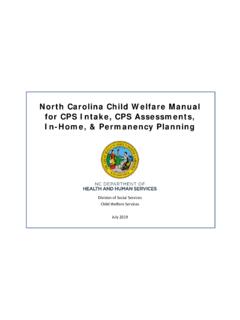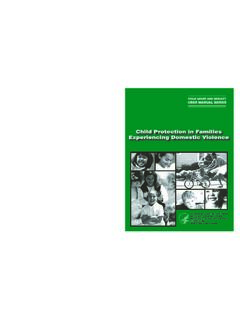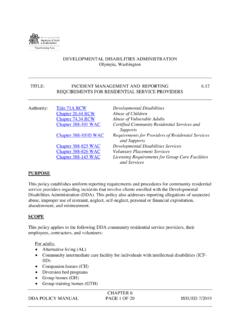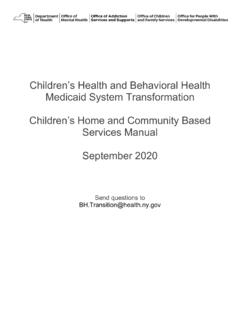Transcription of Mandatory Reporting Guide
1 The Structured Decision Making System South Australia Mandatory Reporting Guide Development Version November 2015 Updated August 2018 2018 by NCCD, All Rights Reserved ACKNOWLEDGMENTS The South Australia Mandatory Reporting Guide represents the contribution of many individuals whose efforts to develop, review and refine the decision trees and their definitions are greatly appreciated. Practitioners and policy officers from the following government and non-governmental agencies contributed to tool development through their 2015 16 workgroup participation. Aboriginal Family Support Services AnglicareSA The Australian Centre for Social Innovation Family By Family Nunkuwarrin Yunti Catholic Education Centacare Catholic Family Services Centacare Catholic Family Services Coolock House Centacare Catholic Family Services Country Centacare Catholic Family Services Domestic Violence Services Child and Family Welfare Association Department for Child Protection Department for Education Department for Health Yarrow Place Department for Health Drug and Alcohol Services: South Australia Department for Health Child Protection Services: Women s and Children s Hospital Department for Health Child Protection Services.
2 Flinders Medical Centre Department for Health Helen Mayo House: Glenside Health Services Department for Health North Adelaide Local Health Network: Lyell McEwin Hospital 2018 by NCCD, All Rights Reserved Department for Health Child and Adolescent Mental Health Service Department for Communities and Social Inclusion Housing SA Department for Communities and Social Inclusion Disability SA Association of Independent Schools of South Australia Relationships Australia, South Australia South Australia Police Uniting Care Wesley Country Department of Human Services Community Youth Justice The South Australia Department for Child Protection is licenced to reproduce, install and display Structured Decision Making materials for internal purposes.
3 Any modification or addition must be approved by the US-based National Council on Crime and Delinquency (NCCD). NCCD will then grant a licence to use such agreed-upon modifications or additions for internal purposes only. 2018 by NCCD, All Rights Reserved TABLE OF CONTENTS GLOSSARY .. 1 PURPOSE OF THIS Guide .. 5 REPORT OF RISK TO CYP CHECKLIST .. 6 CULTURAL NOTES .. 8 PROCEDURES .. 9 TIPS FOR SELECTING A DECISION TREE .. 11 DECISION TREES .. 12 Physical Abuse/Harm .. 12 Definitions .. 13 CYP Likely to Be Removed From the State to be Harmed .. 18 Definitions .. 19 Neglect: Supervision .. 21 Definitions .. 22 Neglect: Physical Shelter/Environment .. 25 Definitions .. 26 Neglect: Food .. 31 Definitions.
4 32 Neglect: Hygiene/Clothing .. 35 Definitions .. 36 Neglect: Health Assessment and Care (Including Mental Health and Disabilities) .. 38 Definitions .. 39 Neglect: Persistent Absenteeism .. 42 Definitions .. 43 Sexual Abuse of CYP Aged 0 17 .. 45 Definitions .. 46 CYP Problematic Sexual Behaviour Self-Directed/Towards Others .. 49 Definitions .. 50 2018 by NCCD, All Rights Reserved Psychological/Emotional Harm .. 56 Definitions .. 57 Parent/Carer Concerns: Substance Abuse/Mental Health .. 59 Definitions .. 60 Parent/Carer Concerns: Domestic/Family Violence .. 62 Definitions .. 63 Unborn Child Abuse .. 66 Definitions .. 67 APPENDIX Reporting a Suspicion That a CYP Is, or May Be, at Risk The NCCD Children s Research Center is a nonprofit social research organisation and a centre of the National Council on Crime and Delinquency.
5 Structured Decision Making and SDM are registered in the US Patent and Trademark Office. 1 2018 by NCCD, All Rights Reserved GLOSSARY Adolescent at risk (AAR) Child/young person (CYP) who is at risk of harm due to mental health or substance use, and the parent/carer is aware of the concern and, through omission or commission, is unwilling or unable to obtain appropriate intervention. Care Team For CYPs under Guardianship of the Minister, the Care Team consists of all the key people involved in the life of the CYP (Department for Child Protection caseworker, parent/carer, educator, mentor/volunteer, NGO, placement support, therapist, family of origin and other natural helpers). CARL Means the Child Abuse Report Line, ph 131478, or online electronic notification through E-CARL at Child/young person (CYP) A person under 18 years of age.
6 Cruising The action of an infant or toddler transitioning from crawling to walking using furniture as an aid to walk. Domestic/f amily violence Domestic/family violence is any behaviour in a domestic relationship, including an intimate partner relationship or a family relationship, which is violent, threatening, coercive or controlling, causing a person to live in fear for their own or someone else's safety. Domestic/family violence includes a broad range of marital and kinship relationships in which violence may occur. Children s exposure to [domestic/family violence] is a serious form of child abuse. It can result in profoundly damaging impacts on children s psychological, emotional and physical safety and wellbeing, as well as compromising their educational and social development by interrupting their schooling attendance and their opportunities to socialise with Domestic/family violence can include physical, sexual, emotional and psychological abuse.
7 See Table 1 for indicators of psychological harm to a CYP. Physical violence can include slaps, shoves, hits, punches, pushes, being thrown down stairs or across the room, kicking, twisting of arms, choking, being burnt or stabbed and so forth. 1 Government of South Australia. (2016, July). Interagency code of practice: Investigation of suspected child abuse or neglect (ICP). Page 13. 2 2018 by NCCD, All Rights Reserved Sexual assault or sexual violence can include rape, sexual assault with implements, being forced to watch or engage in pornography, enforced prostitution, being made to have sex with friends of the perpetrator, or any unwanted sexual contact. Refer to sexual abuse for further information.
8 Psychological and emotional abuse can include a range of controlling behaviours such as control of finances, isolation from family and friends, continual humiliation, threats against children or being threatened with injury or death. Educational neglect Persistent absenteeism from school could be an early indicator of abuse or neglect. If a CYP is school age and persistently absent from school without satisfactory explanation, mandated reporters must consider a notification. Failure to thrive A medical diagnosis for a child who demonstrates inadequate weight gain or growth. Organic There is a biological cause. Non-Organic The cause is environmental. Household All individuals who live within a residence. A CYP may be a member of more than one household if his/her biological parents do not reside together.
9 Infant A child under 12 months of age. mandated reporter A person who comes within one of the categories set out in Section 30 (3) of the Child and Young Person (Safety) Act 2017, and so has an obligation to report a suspicion of a type described in Section 31 of the Act. Non-mobile Describes a young child (infant or toddler), or a CYP with developmental delays or disability, who is not independently mobile (unable to crawl, cruise or walk). Parent/carer A CYP s parent/carer can be any of the following: Biological parent (whether living in the home or not); Legal guardian; Stepparent; Other adult in the household who provides care and supervision for the CYP (other than paid care providers); or 3 2018 by NCCD, All Rights Reserved Intimate partners of a parent, even if they do not live in the home.
10 The following are not included: A CYP who is not a biological parent; An adult not living in CYP s household; and Paid care provider, such as babysitter or nanny. Reasonable suspicion A suspicion is a state of mind. It is different from knowledge or belief. It requires more than a guess but does not need to be sufficient to form a belief as to the existence of an event or circumstance. There does not need to be proof that a CYP is, or may be, at risk. However, there needs to be a factual basis for the suspicion. The suspicion must be reasonable . Whether a suspicion is reasonable will depend on various factors, including the surrounding circumstances and the plausibility of the information available to the Mandatory reporter.






